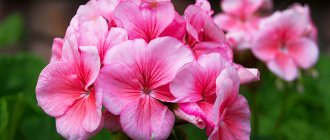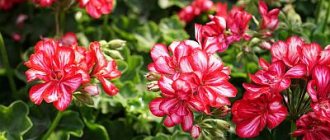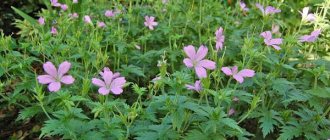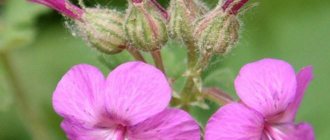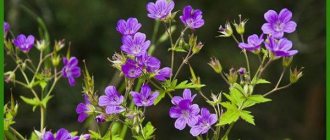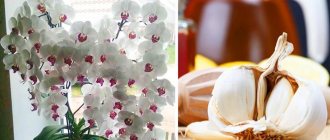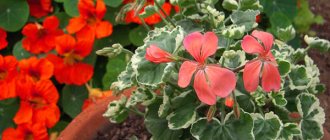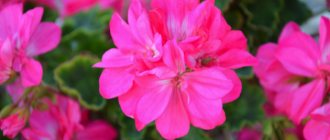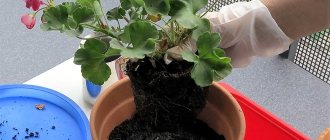Geranium is not only a beautiful flower, but also a real storehouse of useful substances. That is why this plant is widely used in folk medicine. But, even if you just put pelargonium on the windowsill in your home, it will help in the treatment of certain diseases.
In this article we will look at the beneficial properties of this culture and how it can be used to treat various diseases. In addition, we will pay attention to contraindications to the use of geranium, so that the use of traditional medicine does not cause harm to health.
- Effect on the body
- Geranium essential oil
What does geranium look like?
The Latin name for geranium is pelargonium. Many people know this plant by this name. In general, the name of the flower comes from the Greek word “pelargos”, which means “stork”. Geranium fruits really look like a stork's beak.
Despite the fact that geranium is called pelargonium, they are still different flowers, although they belong to the same family. What is the difference between geranium and pelargonium?
Pelargonium flowers differ in shape. They form large umbrella-inflorescences. There are many varieties of this plant: there are white, pink and dark red flowers. There are also two-color varieties.
Geranium flowers consist of 5-7 symmetrical petals. They are often solitary or form semi-umbrella inflorescences. There are flowers with purple and blue inflorescences. White, crimson, and pink plant varieties are popular among gardeners.
Depending on the variety, the appearance of geranium may vary. Zonal geranium has dark green leaves with brown edges, ivy-leaf flowers resemble the shape of ivy, and Angel geranium resembles a pansy.
Geranium flower - benefits and harm
The appearance of the flower is familiar to almost everyone, because in the past this plant was extremely popular (Figure 1). It was often grown at home, in schools, kindergartens and clinics. It was believed that pelargonium has a strong antimicrobial effect and can even prevent a flu epidemic. There is some truth in these words, since this plant really contains many substances that are beneficial to the human body.
Figure 1. Geranium and its healing properties
Externally, the culture resembles a small shrub with jagged leaves covered with small fibers. When you touch these fibers, the culture begins to emit a very characteristic aroma. Domestic species, as a rule, bloom with red inflorescences, but hybrids of other shades are also popular. In addition, there are varieties designed for growing in open ground or in hanging pots.
Medicinal properties of geranium
Steppe geranium has the following effects on the body:
- It has a blood purifying effect, so it can be used to treat gout.
- Relieves inflammation of the mucous membranes of the nose and mouth.
- Has antiviral and antibacterial effects.
- Relieves swelling.
- Is an active antioxidant.
- A decoction of geranium is effective for diabetes, diarrhea, kidney and liver diseases.
- An infusion from the plant can dissolve kidney stones.
- Removes toxins, nucleins and other harmful substances due to a large amount of tannins.
- Some healers use the plant to treat oncology.
- Flowers and leaves have an astringent, tonic, anthelmintic effect.
The healing properties of homemade geranium
Geranium or pelargonium - the one that grows in the house, has similar properties as its steppe relative:
- increases the body's defenses in the fight against acute respiratory viral infections;
- copes with headaches;
- normalizes blood pressure;
- promotes the dissolution of kidney stones;
- copes with depression, decreased mental activity;
- relieves skin problems: burns, frostbite, dermatitis, eczema, etc.
What harm can it do?
Geranium, like many other medicinal plants and medications, can harm your body and has a number of contraindications:
- pregnancy and lactation;
- stomach diseases (ulcers, acute gastritis);
- chronic diseases associated with the activity of the gastrointestinal tract;
- thrombophlebitis;
- increased blood viscosity.
Children and elderly people should not use geranium internally, only externally. Also, do not forget about the body’s allergic reaction. In this case, even keeping the plant on the windowsill can cause a cough, runny nose, and even Quincke's edema.
Dosage forms
Various dosage forms can be prepared from the aromatic plant:
- Essential oil. You can buy ready-made oil at the pharmacy, but you can prepare it yourself.
- Decoction. The crushed leaves and/or roots of the plant are poured with boiling water, the broth is filtered and cooled. The prepared medicine can be taken orally for diarrhea, osteochondrosis, rheumatism, used for gargling and hair, douched for uterine bleeding or female gynecological problems.
- Infusion - dry raw materials are infused in boiled water for at least 8 hours. The resulting infusion should be taken orally to normalize the functioning of the digestive tract, nervous system, etc.
- Freshly squeezed juice - just chop the leaves and stems and squeeze through cheesecloth.
- Dry powder - you can sprinkle it on sores and wounds. This product dries the skin, disinfects the wound, and helps it heal faster.
- Compresses - mash fresh leaves so that they release juice, apply to painful places and wounds.
- Ice cubes – used for facial skin problems.
- Geranium pillow – stuff the pillow with dried stems and flowers. Place it near the bed. This pillow soothes and relaxes, gives you a good night's sleep.
Flower care
Since geranium is unpretentious, caring for it will not be difficult. But in order for it to always have a pleasant appearance and delight you with flowering for a long time, you need to monitor its condition.
Since geranium is a light-loving plant, in the summer it is better to place it on the south side. And in winter it is necessary to position it so that it receives as much natural light as possible.- The room temperature must be at least +10, otherwise the plant will die.
- To form a neat bush, you should trim the top of the geranium in time.
- It needs to be replanted only when necessary. For example, if it has grown from a previous pot.
- It is best to feed geranium with a ready-made mixture for flowering plants. It is worth starting fertilizing several weeks before the start of flowering, then it will last longer. The frequency of feeding should be once every 2 weeks.
- Dried inflorescences and leaves must be removed immediately, otherwise the plant may become seriously ill with a fungal infection.
- When watering, you need to make sure that water does not get on the stems and leaves of the geranium. This can cause irreparable harm, especially to a young plant.
Geranium in cosmetology
Essential oil is made from geranium, which has a powerful effect on the skin, providing it with beauty and youth:
- the combination of geranium and clove essential oil helps cope with acne;
- a tandem of geranium oil and patchouli or chamomile moisturizes and smoothes the skin;
- restores skin tone, smoothes out shallow wrinkles, restores the firmness and elasticity of the dermis;
- normalizes the functioning of the sweat and sebaceous glands;
- strengthens hair, removes dandruff, soothes the scalp, activates hair growth;
- improves the functioning of the gastrointestinal tract;
- treats back problems;
- normalizes heart function;
- the juice of the plant helps to cope with a runny nose;
- Geranium infusion can cure a sore throat.
Geranium oil can be used for taking an aroma bath (add 5 drops of oil to a full bath), for rubbing (5 drops per 10 ml of base oil), and anti-cellulite massage (7 drops per 30 ml of base oil).
Where to put the flower
After weighing all the pros and cons, it is determined whether geranium is needed and whether the plant can be kept in the house. If you want to decorate your interior with brightly blooming pelargonium, you need to think about where it will be most comfortable.
Ampelous pelargonium or geranium - growing and care at home
In order for the plant to have a positive effect on home energy, calm the nerves and create a joyful mood, the choice of place for an indoor flower is approached from the perspective of Feng Shui. Science recommends placing pots of geraniums on a windowsill oriented to the southeast.
Experienced flower growers believe that pelargonium is unpretentious in choosing a place, so it can be placed in any room, regardless of the location of the windows. But frequent relocation of color negatively affects his “mood.”
Note! If the plant begins to smell sharply after moving, it is better to leave it in its original place.
In a private house, pelargonium is planted in a flower bed in the summer. Following Eastern teachings, the best place for geraniums will be flowerpots installed on both sides of the front door. This will help protect the house from bad energy. It is desirable that these are flowers with red petals. They are visible from afar and, according to legend, scare away ogling people.
The plant is in its place
If we take into account the functionality of the premises, then geraniums will be in place everywhere:
- in the living room, a flower will create a friendly, relaxed atmosphere;
- in the bedroom it will set the spouses in a romantic mood;
- in the children's room will ensure healthy sleep and stimulate students to the creative process;
- In the kitchen, geranium is useful for improving digestion.
If there are windows in the bathroom and hallway, then pelargonium would be appropriate here too. By placing geraniums around the house, you don’t have to worry that your family will be bothered by flies, mosquitoes and other harmful insects.
Note! People who are sensitive to odors, but do not want to part with pelargonium, should not keep the flower in the rooms where they relax and work.
Geranium in a flowerpot
There are people who like to grow indoor flowers in a suspended state. Pelargonium can also be planted in flower pots. For this option, only certain varieties from the group of climbing (climbing) plants are suitable.
Pelargonium in a flower pot
Geraniums are hung low in a flowerpot and placed as close to sunlight as possible, choosing an eastern window for the summer and moving it to the south for the winter.
Geranium under artificial light
Not every apartment has windows facing the right direction. If the housewife is forced to keep pelargonium on the northern windowsill, the plant will not have enough sunlight. Therefore, additional illumination with a phytolamp or a fluorescent device will be required.
How to make butter at home?
The essential oil of the fragrant flower is industrially obtained by steam distillation. Typically, oil is extracted from several varieties of pelargonium. Ultimately, the consistency of the product should be viscous, oily, yellow or greenish in color with a tart aroma.
To avoid overpaying, you can make your own butter at home using the following recipes:
- Recipe 1: collect 1 kg of leaves and flowers of the plant, wash them, dry them naturally, chop them. Place the raw material in a glass jar, add water, and close with a nylon lid. Make a hole in the lid, insert a tube there, secure it with plasticine so that it does not fall inside the jar.
Place the outer end of the tube into a small dark bottle. This bottle should be placed in a glass with ice. Close the jar with a lid and tube and place in a water bath. When the contents of the jar begin to heat up, drops of essential oil will begin to appear in the bottle.
- Recipe 2: chop the flowers and leaves of a houseplant (200 g), add a glass of alcohol/vodka. Close the container with a lid and place in a bright place. After 2 weeks, add 50 ml of any oil you wish (olive, almond, etc.). Leave for another 14 days.
Reviews
Catherine:
“I love fragrant geranium, but for me it was very stretched. I placed the pot on the better lit kitchen window. My geraniums have become more lush."
Love:
“I was busy with indoor flowers and found cuttings of dark red and pink double pelargoniums. When my plants became large, I shared the shoots myself. Then something happened that made me believe in the signs associated with geraniums. The people to whom I gave the cuttings were apparently not very kind, because both their geraniums and mine died.”
Chemical composition of geranium
The fragrant indoor flower has a number of useful properties due to its rich composition, which includes:
- glucose – improves brain function, relieves causeless anxiety, fear, depression;
- fructose – tones, relieves fatigue, prevents the development of caries;
- flavonoids – have an antibacterial effect, normalize blood pressure;
- catechins – protect the body at the cellular level, have an antioxidant effect;
- saponins - have a diuretic, tonic, anti-inflammatory effect;
- tannins – have an aseptic, astringent, hemostatic effect;
- carotene – cleanses the body of harmful substances, accelerates the process of cell regeneration, prevents the appearance of malignant tumors;
- vitamin C – slows down the aging process of the body, increases immune defense;
- vitamin K – improves the blood clotting process;
- alkaloids – have a sedative effect, have a positive effect on the cardiovascular system, and have an antimicrobial effect;
- anthocyanins – serve as powerful antioxidants, slow down the aging process of the skin, treat neurological diseases;
- manganese – regulates metabolic processes, reduces cholesterol and fat deposits;
- copper – participates in the production of collagen, normalizes the functioning of the digestive tract.
Where and how to buy?
Recently, geranium has regained its former popularity and acquiring it is not difficult. almost any flower shop you can find seeds or ready-made flowering geranium bushes. You can also contact online stores and various sites where the choice of plants will be larger and more interesting.
Recommendation! If you are interested in rare and unusual types of geranium, then you should contact flower growers and experts abroad who can send you seeds of different types.
Geranium is a unique and wonderful home plant that even a beginner can grow. If you are looking for a beautiful plant for your windowsill, you should turn your attention to geranium, because it is not only a beautiful flower, but also a real storehouse of healing properties.
Home first aid kit: recipes
Indoor geranium has found its use in the treatment of various ailments.
For insomnia and epilepsy
Make a decoction: 1 tbsp. l. crushed leaves and flowers, pour 0.5 liters of boiling water. Leave for 12 hours. Take 1 tbsp. l. every 3 hours.
For constipation
2 tsp. dry raw materials, pour boiled cooled water (0.5 l). Leave for at least 8 hours. Drink in small portions throughout the day.
For toothache
Rinse a fresh geranium leaf and place it behind the cheek on the side of the painful tooth for 20 minutes. Repeat the manipulation as pain appears.
For nasal congestion, runny nose
Place the leaves of the plant in cheesecloth, beat lightly with a hammer, and squeeze out the juice. Place 2 drops of juice into each nostril up to 3 times a day.
With high blood pressure
Bandage a fresh leaf of the plant to the pulse on both wrists.
For neuralgia
Apply the sheet to the sore spot, put linen cloth on top, and bandage it with a warm scarf. Change leaves 3-4 times during the day.
For otitis media
Fold a geranium leaf into a tube and insert it into the sore ear.
For eczema
Dip freshly picked pelargonium leaves into water and boil for 5 minutes over low heat. Make lotions from the warm broth.
For headaches, bad mood
It is enough to inhale the aroma of flowers. To do this, you can touch the leaves or rub one leaf in your palm.
For sleep problems
Place a pot with a plant in the vacationer’s bedroom.
For abdominal pain
Finely chop the geranium leaves, pour boiling water, leave for 5 minutes in a steam bath. Take the decoction up to 4 times a day.
For painful menstruation, heavy bleeding
Take 20 drops of freshly squeezed plant juice. Frequency of application – every 2 hours until symptoms completely stop.
For problems with the gastrointestinal tract
Pour crushed dry leaves and roots of the plant (2 tsp) into 0.5 liters of cold water. Leave for 8 hours. Strain, drink 150 ml up to 4 times a day.
For hemorrhoids
Mash a clean geranium leaf (you can use a mortar) and apply it to the hemorrhoidal bump (for external hemorrhoids).
For any bleeding
Pass fresh leaves and stems of the plant through a meat grinder. Squeeze out the mass. Use the resulting juice for nasal, uterine and other bleeding, making lotions from the juice.
For hair problems
Apply geranium oil to your fingertips and rub the product into your scalp. Wrap your head in a plastic bag and wrap it in a towel. Leave for half an hour, then rinse with warm water and wash your hair with shampoo.
For radiculitis and osteochondrosis
Cut off a dozen leaves of the plant, rinse, and knead in your hands until the juice releases. Apply the leaves to the painful area, cover with plastic, and secure with a warm scarf. Apply the compress before going to bed.
For acne
Grind 3 leaves to a paste. Add sour cream (1 tbsp), stir. Apply the mask to your face and rub in with your fingers. After 15 minutes, rinse with warm water. Frequency of application – 1 time per day.
Anti-aging
Pass the leaves of the plant through a meat grinder. Squeeze out the juice using cheesecloth. Add water in a 1:1 ratio. Pour geranium water into molds and freeze. Rub your face with ice cubes every day.
With regular use of such cubes, the number of wrinkles will significantly decrease, skin elasticity will increase, and a rejuvenating effect will be visible.
For hair loss
Pour boiling water (0.5 l) over dry raw materials (3 tbsp). Cool, strain. Rinse your hair with infusion. No need to rinse off.
Reproduction
The propagation procedure for geraniums can occur in three ways:
- propagation by cuttings;
- propagation by seeds;
- propagation by dividing the bush.
The first method is quite simple to implement. You need to select a cutting that has 3-4 leaves and cut it with a sharp knife. Then it is allowed to lie for several hours so that the cut dries. After this, the cuttings are placed in water, or in a mixture of peat and sand, to take root. After a few weeks, you can safely transplant it into a pot.
The second method is quite long and therefore less popular. Seed propagation is usually used when a new variety of geranium is grown. It is best to plant seeds in early spring, having previously treated the soil with a solution of potassium permanganate to protect the plant from diseases and bacteria. After sowing the seeds, the surface is sprinkled with a thin layer of sand and covered with film to create a greenhouse effect.
After a few days, the film is removed, and after a couple of months you can see the first shoots.
The last method of reproduction is the easiest. The geranium bush is divided into two equal parts with a sharp knife.
Roots and shoots should be on both halves. After division, the cut is treated with crushed activated carbon, and then new bushes are planted in the ground.
Contraindications. Limitations in use
An indoor flower not only helps to cope with various diseases, but can also cause harm:
- The plant or essential oil is non-toxic and non-irritating, but some people may experience an allergic reaction. In this case, you should stop taking the medicinal plant.
- When treating any diseases with geranium, it is important to take a break - 3 weeks of intensive treatment and 10 days of break.
- It is forbidden to take geranium decoction or oil orally on an empty stomach.
- You should not use geranium medicine before bed, as the plant can invigorate.
- Geranium should not be used on pregnant women or children under 6 years of age.
- Individual intolerance is another sign to stop taking the medicinal plant.
- It is forbidden for people suffering from asthma to be treated with geranium.
- It is not recommended to use the plant in any of its forms for chronic gastrointestinal diseases.
- Geranium juice should not be used for thrombosis - it thickens the blood and can aggravate the patient’s condition.
Fragrant, beautiful geranium, decorating the windowsills of many homes, is a real home medicine cabinet. After all, from the leaves, roots and flowers of the plant you can prepare decoctions, infusions and lotions that help cope with pain of various origins and gastrointestinal diseases.
But you should not use this plant thoughtlessly, because in addition to benefits, it can also cause harm. Therefore, before making essential oil or other medicinal form from this flower, you need to undergo a sensitivity test to check for allergic reactions.
Why you should plant geraniums at home
✿ The aromatic leaves have anti-inflammatory and antimicrobial properties. They disinfect and purify indoor air. Thanks to this, pathogenic bacteria are destroyed - you and your loved ones will be under invisible protection from colds and flu.
✿ Protects against unwanted insects: mosquitoes, flies, moths, garden pests, etc. And the essential oil of the plant is considered a powerful natural repellent.
To protect against insects, prepare a composition of 10 drops of ether diluted in 1 liter of water. The finished product is poured into a container with a sprayer and used to treat the entire room.
Diluted oil is non-toxic and will not harm animals.
The product can also be used to protect against lice and fleas.
✿ The aroma of a houseplant improves the energy in the house, protects it from scandals, quarrels and other negative emotions.
In addition, it relieves fatigue, improves mood, and gives a feeling of calm and well-being. To reduce signs of stress and depression, rub the leaf in your hands and inhale its scent deeply. It quickly energizes, relieves irritation and relaxes the body.
✿ Geranium is considered to be a symbol of love. Therefore, it is recommended to place pots with plants in the bedroom to strengthen relationships in couples or to find your soulmate for single people.
✿ The plant has been used since ancient times as a talisman that saved from black power. Women used geranium flowers to decorate their hats, and men put them behind the cuffs of their sleeves.
The flower was also given as a talisman against evil forces, applying the juice to the belly of a woman expecting a child.
Geraniums on the streets of Italy
Signs and superstitions
How to replant geraniums, how to plant a flower step by step
Indoor geranium pelargonium is surrounded by many superstitions. Some of them relate to family well-being, others to peace of mind, and others to financial success. Even if this is only the idle opinion of ordinary people, they are worth paying attention to.
If a person believes in the magical properties of a plant, then he involuntarily tunes in to the desired result. This forces him to act in a certain direction (sometimes unconsciously).
Signs and superstitions about love and family happiness
It has been scientifically proven that pelargonium, with its aroma that exudes phytoncides, can extinguish outbursts of anger. The more negative emotions the geranium absorbs, the more magnificent it will bloom. Thus signaling that there is peace in the house.
People who did not know about the scientific background of this phenomenon endowed the plant with magical properties, reversing the cause and result. They are sure that if geranium appears in the house, happiness will settle there. Evidence of this is folk signs, which also take into account color shades.
Useful and magical properties of the plant
From the above, it is clear why geranium is needed in the house. Realists see healing benefits in her presence. People who believe in the other world endow pelargonium with magic that can not only maintain positive energy in the house, but also attract material well-being.
How to attract money
In the old days, geranium was revered by merchants and bankers, believing that the power of the plant attracted wealth. To verify this, it is recommended to use one of the following methods:
- You should carry a small canvas bag with dried geranium flowers in your wallet or breast pocket;
- you can squeeze juice from the leaves or buy pelargonium essential oil and lubricate the inside of your wallet with it;
- if an important transaction is foreseen, the day before it is recommended to rub a fresh white geranium leaf with the fingers of your working hand;
- It’s worth bringing a flower with you to the company and placing it near your workplace; this will help you tune in to the creative process and make it productive (materially too); will help office workers with their careers.
Note! To achieve high material well-being and attract money into the house, flowers must exude aroma. This is possible if you properly care for your house plants.
Geranium and the signs of the Zodiac
Pelargonium is revered by astrology lovers. It is believed that the plant, like the Moon, influences the fate of people. Geranium affects each sign differently:
- Scorpios, Cancers and Pisces need the flower to relax and get rid of the stress of the working day;
- Pelargonium energizes Capricorns, Leo and Sagittarius;
- Aquarius, Aries, Taurus will put you in a romantic mood;
- It will help Gemini, Virgo and Leo get rid of laziness.
Regardless of the zodiac sign, geranium will be a good protection against negativity from the outside and a talisman against evil spells. The flower helps develop a sense of humor, get rid of complexes and gives self-confidence.
Azalea - geranium's partner
Additional Information. The magical effect of pelargonium will be enhanced by azaleas standing nearby - flowers similar to geraniums in their energy.
Beneficial features
Whether statements about the magical abilities of pelargonium are true or not, it is a fact that the presence of geranium flowers destroys negativity in a room. As well as the fact that the plant can rightfully be called a “folk healer”.
All parts of the bush (roots, flowers, leaves) are used, containing tannins, pectin, sugar, starch, gallic acid, gum and many other useful chemical elements. Thanks to them, pelargonium has bactericidal, antiviral, antiseptic, and diuretic properties. In folk medicine, the scope of application of geranium is quite large:
- with its help you can relieve swelling, stop bleeding and relieve pain;
- Pelargonium is a good remedy for diabetes;
- Geranium decoctions improve blood flow, cardiac muscle conductivity, and regulate rhythm;
- for hypertension, it is enough to apply a plant leaf to the wrist to reduce blood pressure;
- the presence of geranium in the house improves the physical condition of people suffering from problems with the kidneys, gall bladder and gastrointestinal tract;
- crushed leaves in the form of a compress at night will relieve pain caused by osteochondrosis and radiculitis;
- geranium gruel applied to the inflamed area promotes rapid healing;
- diluted fresh juice will relieve pain from otitis media and defeat the disease in 3-4 procedures;
- For older people, geranium will help avoid sclerosis, Parkinson's disease and other problems associated with mental and physical activity.
A houseplant will alleviate suffering from a serious illness if you make tea from red geranium flowers. But you should not take more than 1 cup of this product per week.
Pelargonium is a real antidepressant that helps relieve nervous tension. Its presence in the house is desirable even where it is not customary to plant flowers. If you are not allergic to phytoncides and essential odors do not provoke a headache, you should place at least one pot of geranium in your apartment in a place where it can be clearly seen. What color will be combined with the interior, everyone will decide based on their own preferences.
Possible harm
Indoor geranium, the benefits and harms of which have been carefully studied, can cause serious allergic reactions in people. There is an intolerance to the bright aroma of this plant.
A person develops a runny nose, shortness of breath, sore throat and severe pain in the eyes. If such a reaction occurs, then you will need to get rid of the flower itself in the house and all drugs (both store-bought and home-made) based on it.
The plant may also be harmful to children under 12 years of age and pregnant and breastfeeding women. This is especially true for any medications based on it and traditional medicine recipes.
We should also talk about geranium oil. Overall, this is a useful and safe product. But if used in its pure form, it can harm the human body. For proper and safe use of the oil, it will need to be diluted with other vegetable oils. For example, regular sunflower, coconut, olive.
What ailments and diseases does pelargonium treat?
Geranium is one of the most useful indoor plants. Our ancestors, through trial and error, found out what geranium heals, what are the optimal proportions for preparing infusions, decoctions and tinctures. Knowledge about the properties of geranium leaves, their use for household and therapeutic purposes was passed on from the older generation to the younger.
Effect on the body
Our ancestors knew about the healing properties of the plant, so they planted pelargonium in gardens and grew it in the window at home. Even the presence of a flower in the room had a beneficial effect, because... the plant saturated the air with phytoncides and had an aromatherapy effect.
Compresses, infusions, lotions and decoctions of pelargonium have antiseptic and anti-inflammatory, antiviral and analgesic, hemostatic and diuretic effects. They help with many diseases, ranging from skin diseases, colds and ending with heart problems and blood pressure.
Medicinal properties
Preparations based on geranium relieve pain, inflammation, and swelling. Pelargonium is an excellent antidepressant, normalizes the psychological state, fights sleep disorders, improves performance, and helps with many health problems.
An infusion of the leaves of the plant helps with influenza, ARVI, sore throats, runny nose and cough. Applying the leaf treats otitis media and soothes toothache. Compresses are prepared from crushed leaves for the treatment of radiculitis and osteochondrosis, and the hemostatic effect of the drug is used to stop nasal, pulmonary, and uterine bleeding.
- normalizes the rhythm and functioning of the heart muscle, improves blood supply;
- has a positive effect on diseases of the gallbladder, liver, digestive and genitourinary systems.
What are the benefits of geranium oil?
Golden geranium oil, reminiscent of sunflower oil, exudes a viscous, fragrant odor. The ancient Greeks, Egyptians and Romans used it for inflammatory processes in the spine and premenstrual migraines.
Pelargonium ether, having an antiseptic effect, heals eczema, dermatitis, burns, herpes, and relieves inflammation. It is a proven remedy for the treatment of diseases of the ear, throat, oral mucosa, varicose veins and hemorrhoids; effective for heart diseases.
Aromatherapists advise using pelargonium essential oil to improve the quality of sleep, for irritability, fatigue, and depression. Geranium aroma is useful for headaches, migraines, inflammation of the gallbladder, diseases of the liver, gastrointestinal tract, hypertension, neurasthenia.
